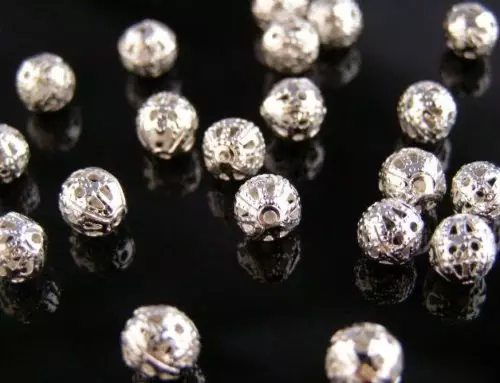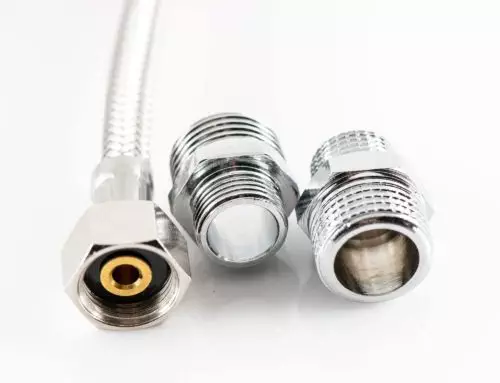Electroplating
Electroplating is a process that uses an electric current to reduce dissolved metal cations (a positively charged ion) so that they can form a thin coherent coating on an electrode. The process begins by lowering a metal object into an electrolyte solution with dissolving ions of another metal type. Once the product is submerged, an electric current is run through both the solution and the object, which forms a bond. The resulting electric charge causes ions of the plating solution to adhere to the surface areas of the metal piece. The longer the object is in the solution the thicker the plating becomes.
Benefits of Electroplating
Electroplating can be done for various purposes including.
- Corrosion Resistance-A corrosion-prone substance such as iron can often be coated with a layer of non-corrosive material such as zinc or nickel, thus forming a protective layer.
- Heat Resistance-Metals with a high heat tolerance are beneficial to certain industries such as aviation or automobiles. These metals can withstand higher heats that are often associated with planes, cars and trucks.
- Mechanical Durability– When a softer, more malleable metal is coated with another material, it often forms a more damage-resistant product. These products are better equipped to handle potential damage.
- Decorative or Ornamental Purposes– Electroplating typically produces a shinier and more lustrous product on a dull surface. For this reason, many retailers are using electroplating for home goods.
- Cost-Effective- Products can be made out of a less expensive metal and coated with a more expensive metal such as gold or silver. This can be a more economical option.
- Conduction – Certain metals have properties that make them transfer heat or electricity. Conductive metals are incredibly helpful in making the electronics, aeronautic, automobile, and communications industries.
Electroplating is typically used in industrial applications for electrical parts or components. When a negatively charged metal is applied to a positively charged metal, the ions attract. While electroplating is typically used for one of the above benefits, it can also be used to reduce friction or protect from abrasion or radiation. Industries from aviation and automobile to communications and healthcare all benefit from this process.
Industrial Plating Types:
Electroplating is typically classified by the type of metal that is used for the coating. The most common metals include copper, tin, zinc, and nickel as well as other various alloys.
- Copper is an excellent conductor of electricity and is the most common choice for communication manufacturers for this reason. It is used in everything from circuit boards and semiconductors to electronic parts and components.
- Tin is relatively soft and malleable and is available in abundance, it is typically the most affordable option. It provides a corrosion protection and matte finish.
- Zinc is another inexpensive metal like tin due to its available abundance. Zinc provides unparalleled protection against corrosion and is commonly for screws, nuts, and bolts.
- Nickel typically hardens the surface of the substrate and increases wear resistance. Nickel is a strong and lustrous metal and is often a base coat to plating a precious metal like gold or silver.
Anodizing
Anodizing is an electrolytic passivation process used to increase the thickness of the natural oxide layer on the surface of metal parts. This process changes the surface of a metal through an electrochemical process without changing the composition of the metal. Anodizing creates a layer with a much higher corrosion and abrasion resistance. Anodizing is a safe process that is not harmful to human health. An anodized finish is chemically stable, is non-toxic; and is heat-resistant to the melting point of aluminum (1,221 degrees F.)
Benefits of Anodizing
Much like electroplating, anodizing has several benefits as well, including:
- Corrosion Resistance-Anodizing creates a layer of aluminum oxide that protects the aluminum beneath it, creating a long life span.
- Mechanical Durability– When anodizing, a total bond and adhesion is created with the underlying aluminum. This gives the products an extremely long life span and durability. There is little maintenance required to restore an anodized surface to its original appearance.
- Decorative or Ornamental Purposes-Anodizing has coats, which allow aluminum to maintain its glossy, metallic finish. It typically eliminates color variations as well. A clear coat can be added giving a lustrous quality to the product.
- Color Stability. Exterior anodic coatings provide good stability to ultraviolet rays, which do not chip or peel. These coatings can be easily repeated.
- Cost-Effective- Aluminum has an inexpensive finishing coat and also has low maintenance costs, resulting in a great low-cost, long-term investment.
Professional companies like Asheville Metal Finishing can assist your business with finding the best option for your products. A professional can help ensure you will not have issues with non-uniform plating as well as determine the most cost effective option for your products. Since electroplating and anodizing is a science, you want to make sure you leave it up to a professional to determine the best solution for you.


